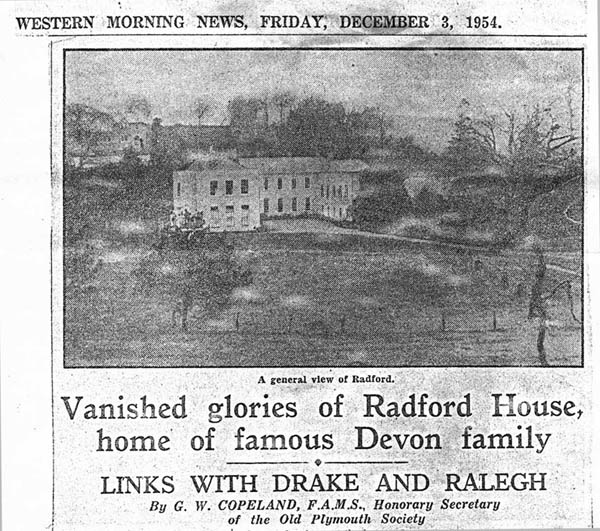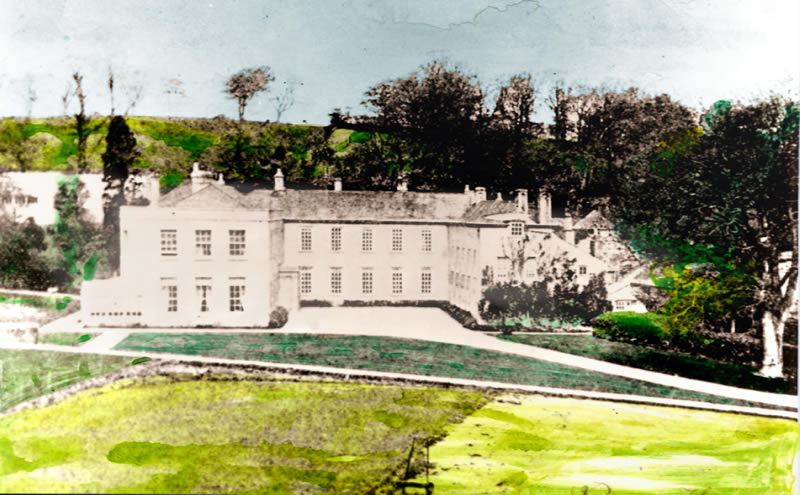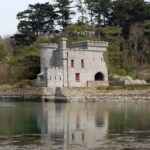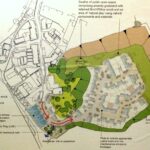Vanished glories of Radford House
 The following is the text from an old news article from the Western Morning News December 3rd 1954…
The following is the text from an old news article from the Western Morning News December 3rd 1954…
A tablet to mark the site of Radford House, one-time home of the great Devon family of Harris was unveiled at Plymstock yesterday afternoon.
Radford, or Redford, so called, it is said, from the colour of the soil, was held by WiIliam le Abbe in the reign of Henry III. (1216-72), one of whose son’s descendants, presumably Walter le Abbe, assumed the name of Radford. We are told that the earliest reference to the place goes back to 1206, and records of the house to the reign of Henry VIII. (1509-47).
The mansion appears to have been the home of the Radfords for many generations, but to have passed to the Harris family, of high repute, during the reign of Edward IV, (1461-83). One of the family, Sir Christopher Harris, at one time M.P. for Plymouth claims our attention.
We are informed, on good authority, that he was a personal friend of Sir Francis Drake, Ralegh, Howard, Hawkins, and others, and that he stored at Radford some of the “gold and silver in blocks” which Drake had brought back from the South Seas. lt is well known that this Harris, as Vice-Admiral of Devon, held Ralegh a prisoner at Radford, on the return of the latter, in 1618, from his disastrous search for gold in Guiana.
FAMOUS FIGURES
As Sir Christopher was a personal friend of Drake and of other famous navel men, we can, without undue romancing, associate them with Radford. But the house which Harris owned, and in which he lived, a house with which many notable Elizabethan figures must have been more or less acquainted,
certainly presented then a very different appearance externally <missing text> safety and subsequently lost. It must have been hidden or buried away from the house, for nearly two centuries later a farmer, when ploughing his fields, found it, and it was eventually sold for £1,255 16s.
MANSION’S FATE
When the fate of the mansion appeared to be sealed, some representations were made locally to try to preserve it. But the state of dilapidation into which this 50 room dwelling was slowly but surely falling, and the ever increasing expenditure with which the Trustees were being faced, determined the issue, and everything structural which represented Radford and it’s immediate dependencies was completely swept away.
Radford was a large mansion in a low situation at the head of Hooe Lake, and it commanded a prospect which was still pleasing 17 years ago. There was some evidence that the earlier house had been quadrangular, and that the two long wings, one on each side of the forecourt, were either complete rebuildings, as far as that at the south-west was concerned, or remodellings, with regard to that at the south-east, the rebuilding having taken place in the mid 18th century, and the remodelling in the late 17th. century.
There was nothing suggestive in the whole house of anything earlier than the late 16th century, which the general remodelling that the whole place underwent in not entirely conceal. It preserved in the central block and the projecting side-wings a reminder of the E shaped plan so popular during Elizabeth I’s reign, though the original main entrance, probably through, a porch in the centre of the main front, was removed at the remodelling and rebuilding.
INTERIOR FEATURES
Parts of the rear of the house and the north-east side still retained their late 16th-early 17th century outline, with dormer windows and panelled chimney-stacks; and a small inner court had a colonnade on two sides.

Underneath the central block was a wine-cellar, apparently coeval with the earlier parts of the house and lighted originally by mullioned stone windows, some of which still remained; and one or two, old wooden barrel-rests had <missing text> rooms had decorative work, occasionally embellished with gesso motifs, largely of the 18th century; there were fanlights over the doorways of Adam design; and some of the doors, particularly to the ground-floor rooms, were of paneled cedar.
From a washhouse at the rear a small staircase led to a room under the roof, the usual “secret” room invented by the romantic-minded to explain the presence of a feature to which no particular use could be ascribed.
And there was, of course, the inevitable ” underground passage,” whose entrance, it was alleged, might be discerned in the vicinity of a fine magnolia which flourished against the south-east corner of the house. ‘This passage was shown fairly conclusively to be merely the inland end of an overflow drain from a small lake which once stood before the mansion. Nor was there any evldence that there were “secret passages and tunnels” behind the panelling on the walls of certain rooms, and that one of the numerous small bedrooms was the actual room in which Raleigh was imprisoned. He had been dead probably a century or more before that room was built!
We have to thank that much criticised period in our history which favoured the erection of artificiaI ruins, put up delibrately to improve(?) the landscape, for such action has preserved for us several genuine fragments from the old house at Radford.
‘SHAM RUINS’
They are to be see among a curious collection of buildings near the head of Hooe Lake. They include a reconstructed “ruined” incomplete facade of a 16th-century house, which incorporates some well-molded doorway heads; a couple ‘ of granite pillars flanking the entrance to a once picturesque boathouse; a small rectangular building, quite wrongly called a chapel, whose attractive front doorway of granite and elvan is reputed to be the original front entrance to the old house, though it appears too small to have served that important purpose; a limekiln treated to masquerade almost as a medieval fortification, by the introduction of such items such as pig-troughs and parts of press-stones, which, when arranged in a certain manner, are often quite misleading and numerous miscellaneous stone fragments.
With thanks to Brian Steele for these documents and others relating to Radford’s history.






I lived on a houseboat on Hexton Quay and can remember venturing through the tunnel at the back of the quay to the quarry beyond. I also remember the cave and like others spent many hours exploring. This was in the late 40’s early 50’s.
I was visiting last year and noticed the work was just about to start on Radford Castle. Hexton Quay is now quite a community.
I’m really enjoying this! I grew up in Goosewell and spent a huge amount of my childhood days playing there- my grandad was part of the ‘Radford preservation society’ I remember planting trees up there, my grandad made labels for the trees, people’s names (the family that donated the tree, I assume) and details of when planted and type of tree etc! He did it on one of those ‘Dymo’ things!
Hi Patrick,
As far as I am aware Radford Cave was capped off a number of years ago and access to the caves is now via a manhole cover. Local caving groups have the key I believe. It lies in Radford woods. I’ll approach local cavers and see if they will create an article for the website.
Would Dave Whittle be so kind as to fix the location of Radford(Or Ralieghs) cave for me, please? We moved to Hooe (from Plymstock, via Oreston)in about 1935. Except for a period in Cornwall (starting shortly after the Turnchapel oil depot was bombed)we remained in Hooe. We lads roamed all over Hooe and Turnchapel but although we had heard of Raleigh’s cave, we never found it. I left in Hooe in 1947 and my youngest sister still lives there.
My father inlay lived in the cottage next to the boathouse on the edge of the lake.he has said it was formerly a chapel but he lived there for four years as a child in the 1930’s.it had 3 bedrooms and a living area and stretched along the site almost to the boat house.in which they used to play.
Thank you so much, i had heard alot about this house as i was growing up. You see my grandmother started working there at the age of 12. Her family lived in Hooe, and she would walk home every Sunday and give her pay to her father. He would give her a penny back, then after tea she would walk back to the big house as she called it. I would love to get some photos, I have one that gran gave me taken by the look of things in around 1917.
Thanks again
Bron
Hullo,
With regard to Radford Duck ponds and the old castle/dam,I worked there as a volunteer in the early seventies,under the group name of the Radford Volunteer Group.
This was run by an Alan Satterly under the councils auspice I believe,but was sadly short lived due to the above nameds’ serious misconduct.
We attempted a renovation of the castle,which largely consisted of brush clearance in the surrounding area,and eating dough nuts.
At the Duck Ponds,we cleared a lot of the detritus which had built up over the years of neglect,and which covered the mosaic(apparently,I never saw that) patterns laid down in the glory days.
With regard to Radford(Or Ralieghs) cave,it was a regular unnoficial outting for most lads from Hooe,using the old carbide lamps and borrowed helmets to investigate such delights as Jacobs ladder,The Trumpet,the Kettle and the infamous “Squeeze”.It was rumoured that the system extended to Crack cave over near to the Duck Ponds,but we never did get that far.
There was an outcry one time at Hooe Juniors when some “Older boys” had let off bangers in the caves,and broken some of the stalagmites (Tites come down-‘Mites grow up…)and defaced the cave walls with carbide grafitti. My memory of the cave walls was that they were always slick with a brown mud,much to Mums annoyance after a clandestine trip down there.
More than one school bully was treated to a little of his own medicine down there,courtesy of the trumpet!
I note that there have been recent fires in Hooe Quarry of late,and wonder if anyone remembers the great explosion circa approx 1970/71?
It was May time,as I was on holiday (and thus can accept no guilt for the fire!)and Leeds Utd were playing Derby I believe in the FA cup,which went to a replay.
Many local residents were evacuated and spent several Nights at Plymstock school,in the main dining hall,with us children being treated to various activities in the church hall near Oreston.
My own parents remained at home on St Johns Drive,looking after our cat which had had his throat cut we believe,in the explosion.
This of course was in the days when long nose tankers would thunder along lake road to the depot,a certain trial for pedestrians exiting the steps off Amacre drive on to the road below.
One last observation and question.
On our many forays into Hooe Lake,despite the ruinous chemical composition,we would often trudge across the mud to the wreck in the centre.There we found many empty jars in what would have been the hold.I can imagine the furore today were children seen attempting that!
My question though is,can any body throw light upon the provenance of the wreck and what those jars were,and if in fact,they were a cargo?
Stuart Brown
Hello,
I came across this site just now which I find very interesting.
I lived in Westfield Avenue from the time it was a newbuild c1950 and the woods at the back of our house was our playground.
NB. Eastfield Ave, Ashery Drive, Broomfield Drive etc were still to be built.
The cave at the back was always known as Raleigh’s cave and local rumour said that it lead to the old Radford House. We never found that route just a collapsed passage way in the cave.
The entrance was completely open and only became shut off after some people were trapped there. Needless to say the entrance was soon broken open again.
With regard to the “sham ruins” I think I should point out that the Wills family lived there for some years, (therefore it was a house) and they were eventually rehoused in one of the older council houses in Meadow Park Road.
I expect some of them are still around – John Wills, Charlie Mills (my age group) are names that come to mind.
Also the farm just along the road from there (Duck Ponds) by Radford Dip was still a working farm then.
Opposite from there, across the road, was all fields then and the only signs of building were the ruins of the old Radford House.
Can you imagine walking the cows across the (Radford Dip) road at milking time now! Different times indeed.
I often think about the memory that around that time that driving to Hooe you would not see any buildings at all on the left hand side between Plymstock (Deans Cross) and Hooe School (apart from just a few opposite Dean Park Road)! Just think of that.
The first to be built on the left were the houses RAF (RN?) married quarters just past there, just before Radford Dip.
Apropos of nothing Radford Dip was much more of a dip than it is now – the local council reduced the dip! Possibly because of the double -decker bus driver who went too close to the trees and ripped the roof of the bus off!
You always had to build up a bit of speed downhill to get you up the other side :o)
Hope you find this interesting and that this adds to your information database :o)
Best regards,
Dave Whittle aka Laurie Whittle